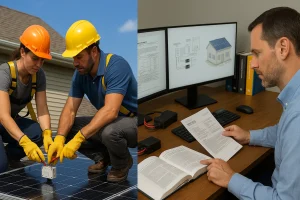Do You Think Solar Rapid Shutdown Is Real? Will It Happen in 2025

Is solar rapid shutdown actually happening, or is it just another regulatory hurdle that might disappear?
This question keeps many solar installers and EPCs up at night, especially when planning projects and budgets for 2025. The reality is stark: solar rapid shutdown requirements are not only real but are actively enforced in 35+ states across America, and they’re here to stay. For solar professionals navigating the complex landscape of NEC compliance, understanding rapid shutdown requirements isn’t optional—it’s essential for business survival and first responder safety.
The good news? There are proven solutions and strategies that successful installers are already using to turn compliance challenges into competitive advantages, ensuring profitable installations while meeting all safety requirements.
What Exactly Is Solar Rapid Shutdown and Why Should You Care?
Solar rapid shutdown is a federally mandated safety mechanism that provides a way to quickly de-energize a rooftop solar panel system during emergencies. Think of it as the emergency brake for your solar installations—a critical safety feature designed to protect first responders and property.

The technology addresses a fundamental challenge: solar panels generate electricity any time the sun is shining, and simply turning off the inverter doesn’t eliminate the electrical hazard. Without rapid shutdown devices, live conductors remain energized, creating serious electrocution risks for firefighters and maintenance personnel.
For solar installers and EPCs, understanding rapid shutdown isn’t optional—it’s the foundation of legal compliance and professional credibility in 2025.
NEC 2025 Rapid Shutdown Requirements: What’s Actually Required
The National Electrical Code has evolved significantly since introducing rapid shutdown in 2014. Here’s what you need to know for 2025:
Current NEC Standards for Rapid Shutdown Compliance
NEC 2017 and later versions require module-level rapid shutdown, where any conductor more than 1 foot from the array or over 3 feet inside the building must be reduced to 30 volts or less within 30 seconds. This represents a dramatic shift from the original 10-foot boundary in NEC 2014.
The most recent updates in NEC 2023 brought important clarifications. The 2023 version explicitly excludes PV equipment and circuits installed on non-enclosed, detached structures like carports and solar trellises from rapid shutdown requirements. This change provides relief for installers working on commercial carport projects and similar structures.
State Adoption Status in 2025
As of December 2022, only 25 states were enforcing the 2020 edition of the NEC, with most others still operating under older editions. However, the trend is clear—states are progressively adopting newer codes, making 2025 a pivotal year for widespread compliance.
Module-Level Rapid Shutdown: Your Compliance Options
Understanding your compliance pathways is crucial for making informed equipment decisions and maintaining profitability.
Three Primary Compliance Methods
- Listed Rapid Shutdown Systems UL system level rapid shutdown certification is mandatory under NEC 2017, requiring both inverter and rapid shutdown device manufacturers to submit for compatibility testing. This ensures system-level safety and inspector confidence.
- Microinverter and Power Optimizer Solutions Microinverter and power optimizer systems like Enphase and SolarEdge are the most popular inverter options for residential solar panel systems in the U.S., both featuring built-in rapid shutdown capabilities. These solutions provide inherent compliance without additional components.
- String Inverter with Module-Level Electronics For installers preferring string inverters, module-level power electronics specifically designed for rapid shutdown can be more cost-effective than installing power optimizers or microinverters.
Rapid Shutdown Device Selection: Maximizing Value for Your Business
Choosing the right rapid shutdown technology impacts your installation efficiency, system reliability, and long-term profitability.

Installation Efficiency Considerations
Quality rapid shutdown devices can be installed to a module in 30 seconds or less with no additional grounding or bonding required. This efficiency directly translates to labor cost savings and improved project margins.
Reliability and Warranty Concerns
The solar industry faces legitimate concerns about rapid shutdown reliability. Module-level power electronics require significantly more components and connection points within the PV system, which can create problems as all these individual components must be properly integrated. However, choosing established manufacturers with proven track records mitigates these risks.
Cost Analysis: Rapid Shutdown Investment vs Business Risk
Understanding the financial implications helps you make strategic decisions about rapid shutdown implementation.
Compliance Costs vs Non-Compliance Risks
While rapid shutdown adds upfront costs, non-compliance creates far greater financial exposure. Failed inspections delay project completion, impact cash flow, and can result in costly rework. In 2025’s competitive market, installers who streamline compliance gain significant advantages in project turnaround times.
Long-Term Business Benefits
Rapid shutdown compliance positions your business for future growth. Rapid shutdown requirements are spreading globally as more countries adopt safety standards for solar PV systems, indicating this technology’s expanding importance beyond US markets.
2025 Market Outlook: Why Rapid Shutdown Compliance Matters More Than Ever
The solar industry landscape in 2025 presents unique challenges and opportunities for installers and EPCs.
Industry Consolidation and Quality Standards

The California Solar & Storage Association reports thousands of stalled projects, over 17,000 industry layoffs, and a wave of high-profile bankruptcies following policy changes and financing shifts. In this environment, companies demonstrating consistent compliance and quality standards gain competitive advantages.
Regulatory Enforcement Trends
Authorities Having Jurisdiction (AHJs) are increasingly scrutinizing safety compliance. Installers with streamlined rapid shutdown processes complete inspections faster, improving customer satisfaction and referral rates.
Best Practices for Solar Installers: Implementing Rapid Shutdown Systems
Successful rapid shutdown implementation requires strategic planning and execution.
Equipment Selection Strategy
Choose manufacturers offering comprehensive support and proven compatibility. Rapid shutdown products should allow plug-and-play functionality with 200+ commercial and residential inverter models to maximize your equipment flexibility.
Installation Training and Quality Control
Invest in proper training for your installation teams. Installation errors such as mismatched or not fully mated connectors can create system problems, leading to callbacks and warranty issues.
Documentation and Inspection Preparation
Maintain detailed documentation of rapid shutdown system specifications and testing results. This preparation expedites inspections and demonstrates professionalism to AHJs.
Future-Proofing Your Solar Business Through Compliance
Strategic compliance positioning prepares your business for continued success.
Technology Evolution and Standards
UL 3741 certification provides system-level safety evaluation, reducing complexity by assessing the entire solar array rather than individual components. Stay informed about evolving standards to make equipment decisions supporting long-term business goals.

Customer Education and Value Proposition
Educated customers make better buying decisions. Explaining rapid shutdown benefits—enhanced safety, code compliance, and system reliability—builds trust and justifies premium pricing for quality installations.
How Energyscape Renewables Simplifies Solar Rapid Shutdown Compliance
At Energyscape Renewables, we understand that navigating rapid shutdown requirements can be overwhelming for solar installers and EPCs operating across multiple markets. That’s why we’ve developed comprehensive compliance solutions that eliminate the guesswork from NEC code adherence while protecting your project profitability.
Our expert team stays current with evolving NEC standards across all jurisdictions, ensuring your installations meet local requirements from the first inspection. We provide complete rapid shutdown solutions including UL-certified equipment specifications, installation guidance, and documentation support that streamlines your approval process.

Whether you’re working on residential rooftops, commercial buildings, or specialized installations like carports and shade structures, Energyscape Renewables has the technical expertise to keep your projects compliant, profitable, and completed on schedule. We partner with leading manufacturers to offer cost-effective rapid shutdown solutions that don’t compromise on safety or performance.
Visit Sunscape Solar to stay ahead of trends and technologies shaping our rapidly evolving industry.

sjayakanth@energyscaperenewables.com